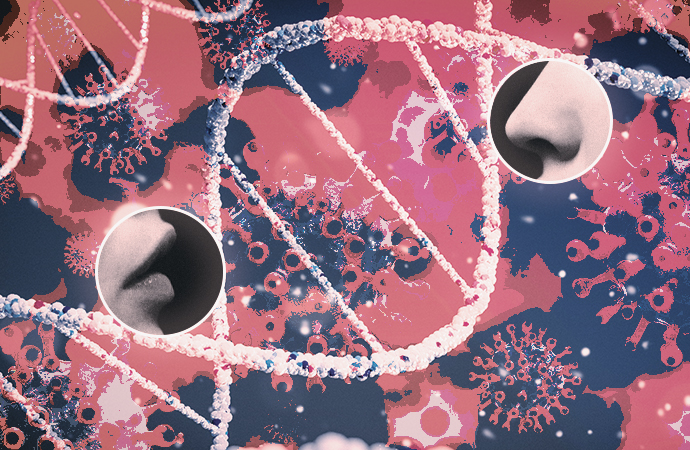Approximately 1.6 million individuals in the United States are still incapable of taste or smell, several months after being affected with COVID-19. In recent times, numerous people diagnosed with COVID-19 have experienced a variation in their capacity of taste or smell, at least once. In the face of this large proportion, the mechanism behind smell/taste loss upon infection is uncertain. According to a current investigation, four of five patients with COVID-19 sooner or later recover their sensory capabilities. However, the prolonged loss of their capabilities can exert an impact on their mental and physical health.
Adam Auton and collaborators executed a genome-wide association study after collecting data from online surveys submitted by 69,841 participants, comprising 37% men and 63% women. All participants were over 18 years old and residents of the United Kingdom or the United States. The researchers identified a group of variants positioned near two genes, namely UGT2A2 and UGT2A1 after the infection.
In their article, published last week in Nature Genetics, they mentioned that these variants augmented the possibility of a person to experience the loss of taste or smell by 11% after being infected with SARS-CoV-2. The UGT2A2 and UGT2A1 genes produce enzymes, which are created in cells present near the inner lining of the nose. These enzymes help eliminate odorants (substances that give a particular odor) attached to receptors associated with detecting smell.
This recent discovery establishes a genetic association between the biological mechanisms of COVID-19. Adam Auton and colleagues made a comparison between 68% (47,298) of the participants who had experienced the loss of taste or smell with 32% individuals positive for SARS-CoV-2 who did not experience these symptoms. Moreover, their research team recognized a lone locus of interest at chr4q13.3 (q arm of chromosome 4).
Adam Auton mentioned that this novel finding can be cited as a striking instance of science where the researchers worked with a considerable number of participants and successfully gained certain biological discernments into this syndrome that has affected people worldwide. However, the research team is yet to investigate the mechanism involving the UGT2A1 and UGT2A2 genes in the loss of sensory perceptions. They hypothesized that these genes possibly play an important role in the physiology of the cells infected with SARS-CoV-2, and the subsequent impairment leads to the loss of smell.
The discovery highlighted that women were more likely to experience sensory loss (11% more) than their male counterparts. In the meantime, adults aged between 26 years and 35 years accounted for 73% of the affected group. The research team also discovered that individuals with African American or East Asian ancestry were suggestively less likely to disclose a loss of taste or smell. Despite an unknown cause of this finding, Auton mentioned that the result was possibly not attributed to the genetic variants of the identified locus. Furthermore, he highlighted the bias towards individuals of European ancestry owing to inadequate reference data.
This finding adds evidence to the biological mechanisms beneath COVID-19-associated loss of sensory abilities. However, the researchers did not differentiate between the loss of smell and taste, both of which were investigated using one survey questionnaire. They concluded by stating the benefits of possible clinical replication of the condition, in place of depending on self-reported disease symptoms.
References
- Shelton, J. F., Shastri, A. J., Fletez-Brant, K., Aslibekyan, S., & Auton, A. (2022). The UGT2A1/UGT2A2 locus is associated with COVID-19-related loss of smell or taste. Nature Genetics, 1-4. https://doi.org/10.1038/s41588-021-00986-w
- Khan, A. M., Kallogjeri, D., & Piccirillo, J. F. (2022). Growing Public Health Concern of COVID-19 Chronic Olfactory Dysfunction. JAMA Otolaryngology–Head & Neck Surgery, 148(1), 81-82. doi:10.1001/jamaoto.2021.3379
- Burges Watson, D. L., Campbell, M., Hopkins, C., Smith, B., Kelly, C., & Deary, V. (2021). Altered smell and taste: Anosmia, parosmia and the impact of long Covid-19. PLoS One, 16(9), e0256998. https://doi.org/10.1371/journal.pone.0256998
- Mastrangelo, A., Bonato, M., & Cinque, P. (2021). Smell and taste disorders in COVID-19: from pathogenesis to clinical features and outcomes. Neuroscience Letters, 748, 135694. https://doi.org/10.1016/j.neulet.2021.135694
featured illustration: Dana Dumea.





